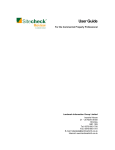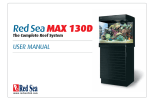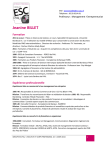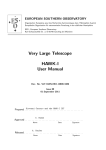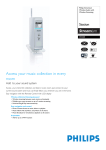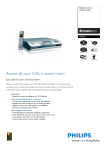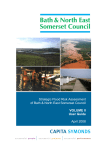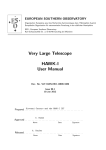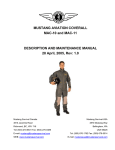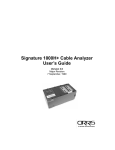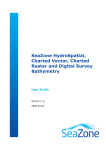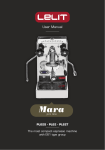Download EX 5766
Transcript
EX 5766 Aggregates Levy Sustainability Fund MEPF 04/03 MARA-GIS, Technical Report Report EX 5766 Release 2.0 September 2008 Aggregates Levey Sustainability Fund – MEPF 04/03 MARA-GIS, Technical Report Document Information Project Report title Client Client Representative Project No. Report No. Project Manager Project Director Aggregates Levy Sustainability Fund - MEPF 04/03 MARA-GIS, Technical Report Defra / CEFAS Patricia Falconer MCS0735 EX 5766 Michael Panzeri Paul Sayers Document History Date 10/06/08 26/09/08 Release 1.0 2.0 Prepared MCP MCP Approved MPD MPD Authorised PBS PBS Notes The contents of this report do not necessarily reflect the views of the Funder Prepared Approved Authorised © HR Wallingford Limited HR Wallingford accepts no liability for the use by third parties of results or methods presented in this report. The Company also stresses that various sections of this report rely on data supplied by or drawn from third party sources. HR Wallingford accepts no liability for loss or damage suffered by the client or third parties as a result of errors or inaccuracies in such third party data. EX 5766 ii R. 2.0 Aggregates Levey Sustainability Fund – MEPF 04/03 MARA-GIS, Technical Report Summary MARA-GIS Technical report Report EX 5766 September 2008 Risk assessment involves an analysis of both the probability of potentially harmful events occurring and the consequential impact of such events. The Marine Aggregate Risk Assessment (MARA) Framework was developed to complement the existing Environmental Impact Assessment (EIA) and Regional Environmental Assessment (REA) processes. Through the provision of a structured risk assessment methodology and an associated supporting GIS based software MARA seeks to formalise the characterisation of probability and consequences together with the transparent representation of uncertainty within the underlying evidence. As such MARA promotes clarity in the evidence gathered through EIAs and REAs and presented to decision makers. The conceptual bias and methods underpinning the MARA framework have been previously described in an earlier ALSF supported project (HR Wallingford Report EX5453, 2007). The subject of this report is the enactment of those methods within a GIS toolset. The MARA-GIS is fully-functional and its utlility is demonstarted through application to a hypothetical case study. The interface and scalability of the GIS supports its use by both consultants, for carrying out an EIA or an REA, and Regulators for reviewing and checking assessments. A particular strength of the GIS framework is that it provides an audit trail of the assumptions and enhances transparency and consistency in the assessment of risks (at all scales). The MARA Framework and associated MARA-GIS bring a consistency of approach to the process of risk assessment in support of both Environmental Impact and Regional Environment Assessments. MARA enables all environmental hazards, receptors and consequences of a dredging operation to be considered within a coherent and transparent manner. MARA involves a structured analysis of the complex interactions and issues that characterise dredging activities. Therefore, although the MARA-GIS provides an easily operated computer package it is not designed for use by inexperienced personnel and requires an experienced GIS users who is both knowledgeable in risk assessment and the potential environmental impacts of dredging activities. The MARA-GIS application has been designed to operate on a typical PC with minimal additional software requirements over those that would be normally used by consultants and regulators (ArcGIS). With minimal training, the appropriate data and with expert judgement a user can now perform a structured probabilistic Environmental Risk Assessment using the MARA-GIS software. EX 5766 iii R. 2.0 Aggregates Levey Sustainability Fund – MEPF 04/03 MARA-GIS, Technical Report The operation of the MARA-GIS is straightforward. It guides the user through the MARA Framework clearly and in a step-by-step manner, feeding back information that has already been entered, verifying that data are correct and highlighting when a step in the Framework is complete or incomplete. At all times, supporting information can be logged to allow the user to enter the source of data or the evidence that may be required to corroborate data. A number of different data formats can be accommodated, from direct entry of values into the forms and entry using slider bars through to loading of values from fields in tables and from CSV files. The fuzzy logic methods developed in the earlier MARA project (to enable uncertainty within qualitative expert judgement and quantitive process models to be combined) have been embedded within the MARA-GIS to support an intuitive and complete representation of the hazards and consequences within the context of a data sparse EIA and REA. The concept of common data libraries (holding receptor’s sentisivity and exposure) included within the MARAGIS will, once widely used, actively support the principle of “collect once use many times” ensuring all assessments use best avaiable data and can be subjected to transparent challenge. The data that is considered within the assessment are stored by MARA-GIS within a single database. It is therefore a straightforward task for a user to enter, review and revise their hazard and receptor data for their EIA. The results of the analysis and information relating to the scope of the licence applications are also stored in the database. The database provides a single source of Environmental Risk Assessment data which can be provided to regulators or stakeholders, allowing them to review all of the data considered during the risk assessment and the decisions made by experts in the field in order to evaluate the risk. Since the MARA-GIS allows metadata records to be entered whenever entering data, it allows the assessor to understand the provenance of the data that has been considered making it easier to obtain and review particular datasets in more detail should this be required. EX 5766 iv R. 2.0 Aggregates Levey Sustainability Fund – MEPF 04/03 MARA-GIS, Technical Report It is however important to note that prior to widespread industry takeup the prototype MARAGIS toolset developed here will require piloting (on real sites) and non-functional refinement prior to open release. EX 5766 v R. 2.0 Aggregates Levey Sustainability Fund – MEPF 04/03 MARA-GIS, Technical Report EX 5766 vi R. 2.0 Aggregates Levey Sustainability Fund – MEPF 04/03 MARA-GIS, Technical Report Contents Title page Document Information Summary Contents i ii iii vii 1. Introduction ...................................................................................................................... 1 1.1 Background.......................................................................................................... 1 1.2 Aims and Objectives of the project...................................................................... 2 1.2.1 Project phasing ....................................................................................... 2 1.2.2 Objectives............................................................................................... 2 1.2.3 Aims ....................................................................................................... 2 1.2.4 Deliverables............................................................................................ 3 1.2.5 Notes ...................................................................................................... 3 2. Risk Assessment and the Marine Aggregate Extraction Risk Assessment (MARA) Framework ....................................................................................................................... 3 2.1 Risk assessment - Underpinning principles ......................................................... 3 2.1.1 What is risk?........................................................................................... 3 2.1.2 Systems approach and risk models......................................................... 4 2.1.3 Units of risk............................................................................................ 5 2.1.4 Recognising Uncertainty ........................................................................ 5 2.1.5 How is the significance of risk perceived and measured?...................... 6 2.1.6 Risk assessment versus risk management .............................................. 6 2.2 The MARA Framework....................................................................................... 7 2.2.1 Overview ................................................................................................ 7 2.2.2 Task 1: Set scope.................................................................................... 7 2.2.3 Task 2: Spatial scale............................................................................... 8 2.2.4 Task 3: Definition of time scale ............................................................. 9 2.2.5 Task 4: Hazard probability..................................................................... 9 2.2.6 Task 5: Receptor presence ................................................................... 11 2.2.7 Task 6: Receptor sensitivity ................................................................. 12 2.2.8 Task 7: Receptor response (uncertainty quantification)....................... 12 2.2.9 Task 8: Risk quantification .................................................................. 13 2.2.10 Task 9: Cumulative and in-combination risks...................................... 15 2.2.11 10: Decision making ............................................................................ 15 3. MARA-GIS .................................................................................................................... 15 3.1 Overview ........................................................................................................... 15 3.2 System and User Requirements ......................................................................... 17 3.3 MARA-GIS Software Design............................................................................ 17 3.4 Data Requirements............................................................................................. 21 3.5 Installation ......................................................................................................... 21 3.6 Operating MARA-GIS....................................................................................... 22 3.6.1 MARA-GIS Task Management Form.................................................. 22 3.6.2 Task 1: Open Database and Set Scope ................................................. 23 3.6.3 Task 2: Hazard State Probabilities ....................................................... 26 3.6.4 Task 3a: Receptor Presence ................................................................. 30 3.6.5 Task 3b: Receptor Sensitivity .............................................................. 32 3.6.6 Task 3c: Receptor Response ................................................................ 33 3.6.7 Task 4: Risk quantification .................................................................. 35 3.7 Audit and control ............................................................................................... 42 EX 5766 vii R. 2.0 Aggregates Levey Sustainability Fund – MEPF 04/03 MARA-GIS, Technical Report Contents continued 4. Conclusions .................................................................................................................... 42 4.1 Overview............................................................................................................ 42 4.2 Benefits .............................................................................................................. 43 4.3 Recommendations for future research ............................................................... 43 4.4 Recommendations for wider application of MARA .......................................... 44 4.5 Final Conclusions .............................................................................................. 45 5. References ...................................................................................................................... 45 Tables Table 2.1 Table 2.2 Table 2.3 Table 3.1 Table 3.2 Table 3.3 Sources – Pathways – Receptors - Consequences ..................................................... 5 Example 3 x 3 hazard matrix with 5 hazard states................................................... 10 (a) hazard probabilities, (b) sensitivity and (c) response ......................................... 13 The stages of MARA-GIS ....................................................................................... 18 Example hazard state matrix.................................................................................... 28 Fields in the risk results layer created using the “Generate Map” button ................ 38 Figures Figure 2.2 MARA Framework Overview ................................................................................... 7 Figure 2.3 (a) Hazard Zones, e.g. numerical model results at 2500 m2 resolution, (b) Receptor Zones, e.g. zones of differing densities of Brittlestar (c) Impact zones, delineated in red......................................................................................................... 9 Figure 2.4 Steps in the quantification of risk in MARA ........................................................... 13 Figure 3.1 Overview of Software Design.................................................................................. 19 Figure 3.2 Adding the “Start MARA-GIS” button to the ArcGIS toolbar ................................ 22 Figure 3.3 MARA GIS Task Management Form...................................................................... 23 Figure 3.4 Open Database and Set Scope Form ........................................................................ 24 Figure 3.5 Licence Locations Form. ......................................................................................... 25 Figure 3.6 Dredge Zones Locations Form................................................................................. 25 Figure 3.7 Dredge Zone Data Form .......................................................................................... 26 Figure 3.8 Hazard State Information Form ............................................................................... 27 Figure 3.9 Metadata form.......................................................................................................... 28 Figure 3.10 Hazard Data Entry Status list box and buttons to enter hazard state probabilities... 29 Figure 3.11 Hazard State Probabilities Form – manual option ................................................... 29 Figure 3.12 Hazard State Probabilities Form – shape attributes option ...................................... 30 Figure 3.13 Task 3a Receptor Presence Form............................................................................. 31 Figure 3.14 Receptor Presence Quantification Form .................................................................. 32 Figure 3.15 Receptor Sensitivity Form ....................................................................................... 33 Figure 3.16 Receptor Response Form ......................................................................................... 34 Figure 3.17 Summary of the processing tasks performed during Task 3c, the calculation of the receptor response................................................................................................ 35 Figure 3.17 Summary of the processing tasks performed during Task 4, the calculation of risk. .......................................................................................................................... 36 Figure 3.18 Risk Quantification .................................................................................................. 37 Figure 3.19 Risk Quantification – example results map: Loss of scallops due to noise ............. 39 Figure 3.20 Risk Quantification – example results map: Loss of scallops due to suspended sediment ................................................................................................................... 40 Figure 3.21 Risk Quantification – example results map: Loss of scallops due to combined suspended sediment and noise hazards .................................................................... 41 EX 5766 viii R. 2.0 Aggregates Levey Sustainability Fund – MEPF 04/03 MARA-GIS, Technical Report Contents continued Appendixes Appendix 1 Appendix 2 EX 5766 Data Required for EIA of Proposed Dredge Sites and Potential Sources Schematisation of model data ix R. 2.0 Aggregates Levey Sustainability Fund – MEPF 04/03 MARA-GIS, Technical Report EX 5766 x R. 2.0 Aggregates Levey Sustainability Fund – MEPF 04/03 MARA-GIS, Technical Report 1. Introduction 1.1 BACKGROUND The UK marine aggregate industry supplies sand and gravel for use in the construction industry, reclamation and beach recharge schemes. During 2006, over 24 million tonnes of sand and gravel were dredged from marine sources in England and Wales (The Crown Estate, 2006). The use of the marine aggregate resource is not without environmental consequences, both positive and negative. Decision makers require support to ensure the exploitation over time, of marine aggregate resources, are optimised and managed to minimise the environmental consequences. To help support this process the marine aggregate extraction industry is highly regulated through a series of mechanisms (i.e. licensing procedures, Environmental Impact Assessment, Electronic Monitoring Systems and monitoring procedures for environmental characteristics). These complex controls seek to ensure that the future development of an extraction site(s) does not have undue adverse impact on the environment. In determining this view the concerns and interests of a wide range of stakeholders are necessarily considered (including the public, local authorities, conservation bodies, archaeological and heritage organisations and other industries that use the marine environment). The Aggregates Levy Sustainability Fund (ALSF) commissions a range of projects, many of which aim to improve understanding of the environmental consequences of dredging activity. This project follows an ALSF project which developed a framework for assessing the risks from marine aggregate extraction. The Marine Aggregate Extraction Risk Assessment (MARA) Framework was developed to explore the potential of an approach for assessing hazard probability and consequences for receptors and presenting these in an overall picture of the risk arising from the dredging activity. The MARA Framework is fully described in Report EX5453 (HR Wallingford, 2007). The reader should refer to this document for the detailed technical background to the methodology. The MARA Framework seeks to be a practical approach to assessing risk at a range of spatial and temporal scales. It enables the assessment of risk at different levels of detail and certainty, depending on the availability of data and knowledge about the physical system and ecosystems. It was developed in the context of the Environmental Impact Assessment (EIA) process and seeks to formalise the characterisation of probability and consequences together with the transparent recognition of uncertainty. The real merit of the MARA Frameworks is its ability to provide an audit trail and a basis for future reevaluation, if required. Importantly the MARA Framework can also provide a basis for evaluating the results of compliance monitoring and optimising the future exploitation of a resource. The MARA Framework follows a systems based approach to risk and is closely linked to the ‘Source-Pathway-Receptor-Consequence’ (‘S-P-R-C’) model as described in HR Wallingford 2005. It also involves the use of statistical minimisation solving routines and is heavily dependent upon the use of Geopgraphical Information Systems (GIS) to perform the spatial calculations within the risk assessment. In order to follow the MARA Framework a user would therefore need to have detailed working knowledge of the ‘S-P-R-C’ approach to systems based risk assessment, statistical optimisation and EX 5766 1 R. 2.0 Aggregates Levey Sustainability Fund – MEPF 04/03 MARA-GIS, Technical Report GIS analaysis. With such a specialist user prerequisite, the uptake of the MARA Framework in such a form is very limited. The current project has been commissioned by the ALSF to develop the software tool MARA-GIS to enable the MARA Framework to be implemented more readily. This report provides both a summarised technical guide for the MARA-GIS software and a detailed user manual. The reader is referred HR Wallingford, 2007 for further detail on the theory of the MARA Framework. 1.2 AIMS AND OBJECTIVES OF THE PROJECT 1.2.1 Project phasing The implementation of the MARA framework within the industry was originally perceived to take four phases: Phase 1 - Development of the methods - MARA Framework (completed and reported within HR Wallingford, 2007) Phase 2 - Enactment within prototype software – MARA-GIS (the subject of this report) Phase 3 - Proving and refinement of the MARA framework and MARA-GIS tools through piloting (a potential future phase) Phase 4 - Roll-out and beta testing by industry (a potential future phase) 1.2.2 Objectives The objectives of Phase 2 were described in HR Wallingford 2007 as to: 1. 2. 3. 4. 5. Develop a GIS-based tool that can be used to implement the MARA Framework. Develop a data protocol that is used within MARA-GIS. Explore the potential for live connections to underpinning datasets. Document the development and use of the MARA-GIS tool. Produce a user guide for how MARA-GIS should be operated. 1.2.3 Aims Five specific aims were identified to address these objectives: To develop a sound conceptual basis of the MARA-GIS • Develop ideas for delivering MARA-GIS, taking into consideration the future evolution of the risk assessment process. • Determine the best approach for developing MARA-GIS. To develop a MARA-GIS • Carry out the programming required to develop MARA-GIS. • The fundamental approach for developing the tool and explanations of how it can be used will be reported in a final technical report. This report will explain the functionality of the tool and could be used as a reference for people who wish to use the tool. EX 5766 2 R. 2.0 Aggregates Levey Sustainability Fund – MEPF 04/03 MARA-GIS, Technical Report To develop an associated data protocol • Document the data formats required for input to MARA-GIS. • Document appropriate data management approach within MARA-GIS. • Explore the potential for live connections to underpinning datasets. This would involve research into the potential for developing a web-based system that could access datasets held by key stakeholders. To test the GIS tools • Verification of tool with case study data from the hypothetical MEPF 04/03 ensuring that qualitative and quantitative data can be used within MARA-GIS and will be capable of storing and analysing a mixture of expert judgement and process model results. To produce a user guide with instructions for using the tool • Produce a user guide with step-by-step type instructions for using the MARA-GIS tool. 1.2.4 Deliverables The deliverables of the project were identified as: • • • The MARA-GIS tool. Final report detailing the development and use of the tool and the data protocol. User guide with details for operating the MARA-GIS tool. 1.2.5 Notes Through post proposal negotiation it was agreed to reduce the project scope by limiting the effort on objective 2; exploration for live connections to underpinning datasets. This may be explored during a later phase of the project. 2. Risk Assessment and the Marine Aggregate Extraction Risk Assessment (MARA) Framework This section is drawn from HR Wallingford 2007 and provides a condensed background to underlying theory of the MARA framework to assist the user of MARA-GIS and is included for completeness. 2.1 RISK ASSESSMENT - UNDERPINNING PRINCIPLES 2.1.1 What is risk? The science of risk assessment has been developed in recent decades to aid a comprehensive understanding of the possibility of harmful consequences occurring as the result from some human activity or natural hazard. The benefit of a risk-based approach, and perhaps what above all distinguishes it from other approaches to design or decision making, is that it deals with outcomes. A risk assessment, for example, would give an expected amount of loss and damage to each receptor influenced by the dredging activity that takes into account all possible levels of hazard and receptor response. This is distinct from more traditional methods that consider only receptor response to a peak level of hazard without necessarily linking the chance of particular EX 5766 3 R. 2.0 Aggregates Levey Sustainability Fund – MEPF 04/03 MARA-GIS, Technical Report hazards occurring with the damage that may be incurred. For example a traditional EIA provides the potential significance of a possible hazard on a receptor, but often fails to describe the chance of this occurring. Risk can therefore be seen to be a combination of the chance of a particular event occurring, and the impact that the event would cause if it occurred. Risk therefore has two components – the chance (or probability) of an event and the impact (or consequence) associated with it. Within the context of MARA, probability and consequence are further described as follows: • Probability – refers to the chance of the consequence occurring. This, in turn, is given by the combined probability that a hazard will occur and that a consequence will arise as a result of that hazard; • Consequence – refers to the undesirable outcome should a risk be realised. It could refer to, for example, the loss of or damage to a habitat, archaeological feature or benthic community. The geographical scale of the consequence may extend beyond the local source of the hazard. It is also necessary to consider the duration for which the hazard is present as well as the duration for which consequences will be experienced and the length of time recovery takes. 2.1.2 Systems approach and risk models Risk Assessment is achieved by understanding the occurrence of harmful events and responses to those events within a system. An understanding of the way a system behaves and in particular the mechanisms by which it may fail, is an essential aspect of understanding risk (Sayers et. al., 2005). A systems-based approach to risk assessment aims to describe each element within the system and represent the links between them to provide a structured characterisation of the system behavior. There are a number of models for characterising a system and system risk in order to help the process of risk assessment. The MARA Framework is closely linked with the ‘Source-Pathway-Receptor-Consequence’ (‘S-P-R-C’) model. The ‘S-P-R-C’ model assumes that for a risk to arise there must be a hazard that consists of a ‘source’ or initiator event (e.g. suspended sediment); a receptor (e.g. benthic ecology); and a pathway between the source and the receptor (e.g. advection of a dredge plume). The consequence of the event for the receptor is determined by the way in which the receptor responds to the hazard and the outcome may be expressed in social, economic or environmental terms. Table 2.1 gives an indicative list of system elements for MARA and their S-P-R-C classifications. EX 5766 4 R. 2.0 Aggregates Levey Sustainability Fund – MEPF 04/03 MARA-GIS, Technical Report Table 2.1 Sources – Pathways – Receptors - Consequences PATHWAYS SOURCES • • • • • • • • Seabed sediment Bedforms Sediment transport Bathymetry Waves Tidal regime Suspended sediment Dredger • • • • • • • • RECEPTORS Removal of seabed Dredge plume Dredge vessel Sediment Water Marine systems Coastal systems Noise • Geomorphology • Marine ecology • Archaeology and heritage • Human uses of the marine environment Receptors are also termed receptors in MARA – this part of the model maps directly to the receptor presence and sensitivity assessments within MARA. Sources and Pathways relate to hazards in MARA – what causes hazards and how do they spread through the study area. CONSEQUENCES • Social • Economic • Environmental Consequences are also termed consequences in MARA. The units of risk communicate the type of consequence (expected £ revenue lost, expected loss to species population etc.). 2.1.3 Units of risk The units of risk depend on how the likelihood and consequence are defined. Likelihood can be expressed as a frequency or probability; consequence is measured in units that are appropriate for the receptors and the information that is required for decision makers. Definitions are provided below: • Probability – may be defined as the chance of occurrence of one event compared to the population of all events. Therefore, probability is dimensionless – it can be expressed as a decimal or a percentage and must be referenced to a specific timeframe, for example as an annual exceedence probability or lifetime exceedence probability. • Consequence – represents an impact such as economic, social or environmental damage or improvement. An example of a negative consequence would be the destruction of sabellaria spinulosa reef environment. • Risk – is the combination of likelihood and consequence and the units of risk will reflect this. The output of the risk assessment for dredging activity will list the risks by receptor, with a unit of risk that is appropriate to that receptor. The risk, for example, to commercial fisheries may be quantified as average annual loss of income; for archaeological features risk may be quantified as number of features or area of feature damaged or destroyed; and for juvenile scallops risk may be expressed as numbers stressed or killed. 2.1.4 Recognising Uncertainty In assessing the impact of marine aggregate extraction there is often considerable difficulty in determining the likelihood of some hazards occurring, establishing the EX 5766 5 R. 2.0 Aggregates Levey Sustainability Fund – MEPF 04/03 MARA-GIS, Technical Report presence and distribution of receptors and understanding how they will respond to the hazard. Models and expert judgment are used to inform the estimation of probability and consequence but both are incomplete representations of reality and so are inherently uncertain. Thus there is a difference between risk and uncertainty: • Risk – typical reflects the expected magnitude of harm - based on a simple product of single estimate probability values and uniquely associated consequences. • Uncertainty – reflects our lack of sureness about something and in context this translates through uncertain (fuzzy) descriptions of both probability and consequence. The MARA Framework (HR Wallingford 2007) has been established to enable this uncertainty to be explicitly handled and propagated through the risk assessment and decision process. 2.1.5 How is the significance of risk perceived and measured? Intuitively it may be assumed that risks with the same numerical value have equal ‘significance’ but this is often not the case. To understand the significance of risk, therefore, it is important to take into account its constituent parts; distinguishing between rare, catastrophic events and more frequent less severe events. The notion of ‘significance’ is influenced by individual and societal perception of risk that can lend it importance that has little relation to its actual level. For this reason, it is useful for the risk results to be recorded as a distinct output, as well as within the overall ‘significance’ results. By separating individual value judgments on importance and ‘significance’, the regulator, stakeholders and the dredging applicant can see what the actual risk is, compared to the perceived risk. The MARA Framework does not support the assessor in their assessment of importance, significance or acceptability, but simply provides a transparent assessment of the risk. This is not to imply that the process of appropriately considering importance, significance and acceptability should not be done; on the contrary, this is crucial to the wider decision-making process. The suggestion is rather that these subjective judgments be separated from the risk result so that the difference between the actual risk and the significance that is attributed to it is transparent to all stakeholders. This will allow an open discourse on the value given to particular consequences identified in the risk assessment, reduce the gap between actual risk and perceived risk and encourage transparent decision making regarding licence applications. MARA-GIS supports this process by capturing and storing all of data used within the risk assessment and making it possible to audit trail the process from beginning to end rather than simply reviewing the outcomes. This should enable the assessor to make more informed decisions regarding the significance of the risk. 2.1.6 Risk assessment versus risk management A risk assessment attempts to provide a reasoned, objective quantification of the risk. The information provided by the risk assessment can then be used by decision makers to support management actions. However, the dredging industry and associated regulation deals with complex decision-making processes, weighing up a set of often competing factors. This process involves the views of decision makers and stakeholders on whether the different risks are unacceptable, tolerable or broadly acceptable (see Section EX 5766 6 R. 2.0 Aggregates Levey Sustainability Fund – MEPF 04/03 MARA-GIS, Technical Report 2.2.5). Understanding the wider social, economic and policy context of the industry is therefore essential when interpreting the outcome of a risk assessment, thus the remit of risk management presents challenges beyond the risk assessment process itself and is outside the scope of MARA. 2.2 THE MARA FRAMEWORK 2.2.1 Overview The MARA Framework was developed during the predecessor to this project by a consortium lead by HR Wallingford. It was developed to allow implementation of the principles of risk assessment described in Section 2.1 for marine aggregate extraction. It is tiered to allow consistent multi-scale application at different levels of detail and certainty. MARA can use any relevant type of qualitative and quantitative information, including numerical model output and expert judgment. Figure 2.2 shows an overview of the processes within the MARA Framework. This is described briefly in the following sections and more fully in HR Wallingford 2007. MARA Framework for Risk Assessment 1. Set scope 4. Hazard probability 7. Receptor response (uncertainty quantification) 2. Initial definition of spatial scale 3. Definition of time scale 5. Receptor presence 6. Receptor sensitivity 8. Risk quantification 10. Decision Making Figure 2.2 9. Cumulative and incombination impacts Risk Management Issues e.g. importance, policy, acceptable risk MARA Framework Overview 2.2.2 Task 1: Set scope The first stage in the Framework is to capture the scope, such that the context of the risk assessment is clear and documented. This effectively sets out the problem that has to be analysed. To specify the scope of the work, it is necessary to describe the proposed dredging activity, which may include details on: • • • • • • EX 5766 the size and location of the area for which a licence is requested the size and location of potential dredge zones within the licensed site the type and amount of aggregate to be extracted the frequency of dredging any seasonality of dredging the method of dredging including whether screening measures are to be used. 7 R. 2.0 Aggregates Levey Sustainability Fund – MEPF 04/03 MARA-GIS, Technical Report The detail to which each of the above will be described will depend upon the nature of the decision and the evidence required to support it; for example a regional assessment will require a different level of detail compared to a single licence application. This is recognised within MARA and the Framework is largely independent of the detail of the analysis. 2.2.3 Task 2: Spatial scale The Framework can be applied to assess risks arising from marine aggregate extraction at any spatial scale including: • • • Dredge zone: assesses the risks arising from the extraction of aggregate within one dredge zone that is within a licence site. Licence area: assesses the risks arising from the extraction of aggregate within a licence site. Regional area: assesses the risks arising from the extraction of aggregate within a region. This takes into account the cumulative effects of dredging activities in different licence sites. At the start of the risk assessment process, it is important that the spatial scale of the assessment is defined. Defining the risk system The spatial extent of the risk system must encompass all the hazards arising from the proposed dredging and the receptor locations. Its boundary therefore is to be defined by the zone of influence of the hazards and location of receptors. The risk system should also be adapted to allow consideration of cumulative and in-combination effects. Defining impact zones The MARA methodology calculates risk within a given area, the ‘Impact Zone’, for a given period of time. Within an impact zone the characteristics of the hazard and receptor response are assumed to be homogeneous. Each Impact Zone is also considered to be autonomous; where the risk within each Impact Zone occurs independently of its neighbours and so the method does not represent the migration of receptors from one Impact Zone to another. Within the risk system there may be few or many impact zones. The spatial definition of Impact Zones, in line with the concept of the tiered risk assessment approach, will vary according to the rate of change in hazards, the level of detail in the survey information and the level of detail required by the assessment. Likewise, the impact zones may be defined in two- or three-dimensions, evaluating risk over the seabed or a volume of water. The boundaries and spatial extents of Impact Zones on the seabed and through the water column need not be the same. Impact Zones may be irregularly shaped and vary in size across area of the risk system; enabling smaller Impact Zones to be used in areas of importance or where the hazard is rapidly changing (for example close to the dredge activity). The Impact Zones are defined by spatial intersection of the hazard zones and receptor zones. Each layer of information is ‘cut’ into the other to produce the Impact Zones such that Impact Zones are the smallest common denominator of all spatial input data. Figure 2.3 shows an example of the spatial intersection of two input datasets, which is described in further in Section 2.2.9. EX 5766 8 R. 2.0 Aggregates Levey Sustainability Fund – MEPF 04/03 MARA-GIS, Technical Report Figure 2.3 (a) Hazard Zones, e.g. numerical model results at 2500 m2 resolution, (b) Receptor Zones, e.g. zones of differing densities of Brittlestar (c) Impact zones, delineated in red The bold red shows one of the impact zones where the boundary of a Receptor Zone intersects a Hazard Zone. 2.2.4 Task 3: Definition of time scale The time scale for the assessment must be set in relation to the dredging activity. The risk assessment is carried out for a specified time duration, t, during which dredging takes place. The duration of t will normally relate to the scale of the assessment. For example, for assessments carried out at a single licence scale, t may be the duration of the licence that is being applied for. However, if the dredging activity were seasonal then it would be more appropriate to carry out an assessment for each period of activity and aggregate the results to quantify overall risk. Risk assessments for multiple licence areas within a region would require the duration of t to encompass all of the periods of dredging throughout the region. The time scale of the risk assessment considers only the physical changes and receptor response to those changes occurring during the active period of dredging. It is recognised that there may be a number of relevant processes occurring after the dredging period that are necessary to take into account, namely; • • • The residence of hazards within the system beyond the period of dredging The response of receptors to hazards remaining within the system The recovery of the receptors. 2.2.5 Task 4: Hazard probability A hazard is a physical change that has the potential to cause harm. Dredging activity will result in a number of physical changes, such as removal of the seabed and creation of a dredge plume. Each of these physical changes, or hazards, will vary in magnitude over different spatial and temporal scales so the characteristics of the hazard (e.g. magnitude and duration 1) for a particular location can be represented by a probabilistic distribution. The risk assessment process uses information from the whole range of the probability distribution, so that infrequent, high magnitude events are considered as well as frequent, lower magnitude events. Hazard assessment therefore requires the definition of the probability of occurrence for the range of possible values, or states, of relevant hazard characteristics for each impact zone. 1 Note that frequency is often noted in EIAs as a relevant hazard characteristic. In the MARA Framework, the evaluation of frequency is implicit in the assessment of probability. EX 5766 9 R. 2.0 Aggregates Levey Sustainability Fund – MEPF 04/03 MARA-GIS, Technical Report Hazard characteristics are the aspects of the hazard such as magnitude, duration and rate that describe the nature of the hazard at a particular location. The ‘hazard state’ is a particular grouping of hazard characteristics. For example, if a hazard is described by the characteristics of magnitude and duration and each of these characteristics were defined as either zero, low or high, then there are 5 possible hazard states as depicted in Table 2.2, where the greyed-out boxes are states that cannot occur. Table 2.2 Example 3 x 3 hazard matrix with 5 hazard states Duration 0 low high 0 No hazard Magnitude low high low - low low - high high - low high - high The hazard characteristics should be most relevant to those which affect receptor response and to the determination of consequences. This requires some understanding of the particular Hazard States that the receptors are sensitive to. Consider, for example, the hazard of the suspended sediment created by the dredge plume. An ecologist would be able to advise that both magnitude and duration of the suspended sediment were characteristics that could influence the response of the ecology that was exposed to the hazard and may also be able to advise on thresholds for the hazard states. For the magnitude of suspended sediment, if a particular species would die given short term exposure to suspended sediment concentrations over 100 mg/l and another species would die with short term exposure to concentrations over 50 mg/l, then it would be useful to have information on three categories (< 50 mg/l, 50 – 100 mg/l and >100 mg/l) in order to discern the various responses of the different species. It is also necessary to take into account the range of values of the hazard state across the risk system in order for the matrices to show the changes in hazard. The hazard category thresholds should therefore be determined as appropriate for the receptor sensitivities. Having determined which hazard characteristics are important and how they will be categorised, it is necessary to assign probabilities to each possible hazard state. This is completed for a specific spatially referenced hazard zone, so it is necessary to identify and map hazard zones throughout the risk system, with each hazard zone representing a change in the hazard levels. Quantified probabilities (i.e. from 0 to 1 inclusive) are required for each hazard state. The best way of identifying these is likely to vary between hazards and may include, for example, process modelling or expert judgement. To determine the probability of occurrence for each hazard state, it is necessary to understand what influences the probability for the particular hazard under consideration. It is worth noting here that in MARA, the Hazard represents the Source and Pathway in the ‘S-P-R-C’ risk model. For the example when considering suspended sediment, the variables that influence the probability of the hazard state include: • • EX 5766 Location – the exact location of the dredging activity within the licence area is not necessarily pre-determined. Albeit the dredging activity will take place with due recognition of any zoning that has been imposed within the site. Source – the amount of fine sediment that is discharged from the dredger as overspill and screening determines the source term for the dispersion of the plume of sediment. This amount may vary with operating pattern and in different sea states (with rougher conditions there may be more overspill). 10 R. 2.0 Aggregates Levey Sustainability Fund – MEPF 04/03 MARA-GIS, Technical Report • Hydrodynamic and meteorological conditions – the wind, waves and tidal currents influence the dredge plume and are subject to natural variation. It is necessary to consider the potential variation in each of these variables and understand the probability of each different type of condition occurring in order to determine the Hazard State probabilities for MARA. Uncertainty in the probability of the hazard state is represented by estimating an upper and lower bound for the probability specified for each hazard state. A ‘best estimate’ may also be specified if appropriate. These uncertainty estimates are used in the calculation of risk and influence the upper and lower bounds of the results. 2.2.6 Task 5: Receptor presence The term “receptor presence” is an expression of the number of receptors that are present within the risk system. It is important to establish the spatial distribution of receptors across the system. There may be a range of different types of receptor, for example, marine archaeology, ecology, geomorphological features; and it is important that these different types are all represented. One very important question is how to quantify each receptor appropriately. This has a bearing on the final communication of the risk assessment results because the units of risk will be determined by the units of quantity selected to measure receptor presence. Some common measures of receptor quantity include number counts, abundance, biomass, area and volume. Having determined the units that appropriately describe the receptor presence, it is necessary to map and quantify receptors through the risk system. It should be possible to determine receptor presence via a combination of survey data, information on general distribution and abundance and informed judgment. Of course, one of the difficulties in defining the quantity of receptors in the risk system is that many receptors, particularly those within the ecological category, are mobile. For mobile receptors, it is necessary to estimate the quantity that would be present within the risk system at any one time (without the presence of the proposed dredging activity). For receptors with a seasonal presence, this can be dealt with either by splitting the timescale of the risk assessment into seasonal time periods, or by incorporating a probability assigned to the receptor presence. It is recognised that the quantification of receptor presence is not a simple task and sometimes involves large uncertainties. However, quantification is crucial to establish the risk to the system. The uncertainty in presence should be expressed as upper and lower boundaries around a ‘best’ estimate. So, for example, for a risk system that is populated by cod, a lower estimate, an upper estimate and a best guess may be given for the abundance of cod over the area of the system. By taking into account the range of potential presence values, the final result will communicate the range in numbers that are potentially at risk. If the range is great, it may mean that if the upper estimate were used, the risk would be deemed unacceptable and the licence would not be granted; whereas if the lower estimate were used the licence would be granted. In this case, it may be decided that it is necessary to collect more survey information to reduce the uncertainty in the receptor presence term so that an appropriate decision can be made. Alternatively, other risk management measures to mitigate the impacts may be implemented. EX 5766 11 R. 2.0 Aggregates Levey Sustainability Fund – MEPF 04/03 MARA-GIS, Technical Report 2.2.7 Task 6: Receptor sensitivity Receptor sensitivity considers how the receptor will respond if exposed to a particular hazard. There may be different levels of response including no response, stress, damage, destruction, death, migration, beneficial response etc. MARA considers the negative responses only and the sensitivity considered within MARA does not provide any information on recoverability or importance of receptors; these are outside of the scope of MARA and are dealt with elsewhere in the assessment. The receptor sensitivity must be defined for each of the Hazard States. It is therefore important to consider the receptor sensitivity when defining the hazards. In determining the sensitivity relationships, it is necessary to establish a relationship between the probability of loss and the hazard characteristics. Loss may be defined as any particular response such as damage, death, stress etc., as long as this is explicitly specified. When determining the relationship, the probability of loss must be considered for one unit of the receptor only. So the question posed to an expert could be, for example; “what is the chance that 1 m2 of receptor x will be destroyed as a result of this particular combination of hazard magnitude and duration?” The answer can be given as a quantitative probability or as a qualitative judgment using high, medium, low. Any qualitative evaluation will be converted into a quantitative measure for use in the rest of the assessment process. The evaluation of receptor sensitivity to different hazards can be used in subsequent assessments and so the outputs may be retained in a database. This is discussed further in Section 4. Estimating receptor sensitivity is an uncertain process and this should be recognised by the specification of optimistic and pessimistic estimates, and a best estimate if appropriate. Through time such uncertainty bands may be expected to gradually diminish as knowledge improves. 2.2.8 Task 7: Receptor response (uncertainty quantification) Given that a probability has been defined for all Hazard States (described in Section 2.25) and a sensitivity has been defined for all Hazard States, it is possible to calculate the receptor response (or loss) for each Hazard State as follows; p(li ) = p( Hi) × p( Si ) (Equation 2.1) where; p (li ) = probability of response for hazard state i p(Hi) = probability of occurrence for hazard state i and p (Si ) = probability of sensitivity to hazard state i. It follows that the total probability of receptor response to a given hazard is determined by summing the receptor response for all Hazard States. Equation 2.2 and Table 2.3. n p(l ) = ∑ [ p(Hi ) × p(Si )] (Equation 2.2) i =1 Where n = number of Hazard States EX 5766 12 R. 2.0 Aggregates Levey Sustainability Fund – MEPF 04/03 MARA-GIS, Technical Report Table 2.3 (a) hazard probabilities, (b) sensitivity and (c) response Hazard Sensitivity p (H1) p (H2) p (H3) p (S1) p (S2) p (S3) p (H4) p (H5) p (H6) p (S4) p (S5) p (S6) p (H7) p (H8) p (H9) p (S7) p (S8) p (S9) Response p (H1) x p (H2) x p (H3) x p (S1) p (S2) p (S3) p (H4) x p (H5) x p (H6) x p (S4) p (S5) p (S6) p (H7) x p (H8) x p (H9) x p (S7) p (S8) p (S9) Sum = probability of receptor response (p(l)) Sum = 1 The approach for dealing with uncertainty within MARA framework is based on interval probability theory. The Hazards State are mutually exclusive thus the sum of the Hazard State probabilities must equal 1. Since MARA allows for the uncertainty in Hazard State probabilities to be captured via upper bound and lower bound estimates, it follows that the sum of lower bound probabilities will be less than 1 while the sum of the upper bound probabilities will be more than one. This is resolved by using a statistical optimisation routine to solve the Hazard State Probabilities which yield the maximum total response (upper bound) and the minimum total response (lower bound) by allowing the probability for each Hazard State to vary between the upper bound and lower bound input values entered while constraining the sum of all hazard state probabilities equal to 1. 2.2.9 Task 8: Risk quantification Within MARA, risk is quantified by multiplying the probability of receptor response by the receptor presence. This calculation is carried out for each impact zone (as described in Section 2.2.3) so that the spatial correlation of the influence of each hazard on each receptor can be taken into account. Figure 2.4, summarises the steps involved in the quantification of risk. 8. Risk quantification 8a Expected impact zone risk 8b 8c Total expected impact zone risk 1 receptor, 1 hazard 1 receptor, all hazards For each receptor, calculate the risk in the impact zone as a result of each hazard. Do this for all impact zones within the risk system. For each receptor, calculate the total risk for each impact zone by considering the combined risk from all the hazards present within the impact zone. System risk For each receptor, calculate the total risk by summing the risk calculated for each impact zone. 8d Whole-life system risk Consider: • Residence of hazards within the system. • Continued response of receptors to those hazards. •Recoverability of receptors. Figure 2.4 EX 5766 Steps in the quantification of risk in MARA 13 R. 2.0 Aggregates Levey Sustainability Fund – MEPF 04/03 MARA-GIS, Technical Report Expected Impact Zone Risk In order to calculate the risk to a Receptor in an Impact Zone, it is necessary to quantify the receptor presence within the Impact Zone. Since the Impact Zones are determined by performing a spatial intersection of the Hazard Zones and Receptor Zones (see Figure 2.3) it is necessary to calculate the presence data for each Impact Zone using an area weighting or density based calculation from the original Receptor Zones boundary data. Once the receptor presence has been calculated for each Impact Zone, the expected impact zone risk for one receptor (receptor x) as a result of one hazard (hazard y) is thus: r(receptor(x), hazard(y)) = m(p(l)) (Equation 2.3) where r is impact zone risk (whether that be damage, death, stress etc.), m is the receptor presence for the impact zone and p(l) is the probability of receptor response as given in Equation 2.2. Upper bound and lower bound expected impact zone risk are calculated by multiplying the lower value of p(l) from the optimisation process described in Section 2.2.8 with the lower estimate of receptor presence to give the optimistic result and the upper value of p(l) from the optimisation process with the upper estimate of receptor presence to give the pessimistic result. The outcome of this calculation will be a quantification of impact zone risk, in the same units that describe receptor presence, for each receptor as a result of each hazard. In order to carry out the calculation of p(l), any parameters that have been quantified in previous stages with a continuous scale must be discretised. The coarseness of the discretisation will influence the final risk result and sensitivity testing on the assessment would ideally be carried out to find the most appropriate number of values to select. If the previous stages of the assessment have characterised the hazard assessment and receptor sensitivity in categories, for example, by giving relationships in matrices, this is readily usable in the risk calculation. Total expected impact zone risk To find the total expected impact zone risk from all hazards, it is necessary to consider the combined influence of all hazards occurring within the impact zone. This is achieved via interval probability theory for each receptor by considering the likelihood that the receptor is not lost due to each hazard, enabling the function to quantified relating to the receptor not being lost due to all hazards. The inverse of this gives the total expected Impact Zones Risk from all hazards as described below: r(receptor(x)) =m(1 – [(1 – p(l)hazard 1) × (1 – p(l)hazard 2) × .... (1 – p(l)hazard n)]) (Equation 2.4) This approach does, however, lack any representation of mutually inclusive or exclusive hazard influences. System risk Up to this point in the assessment, risk has been considered at the scale of the impact zone. In order to get an overall picture of risk, it is necessary to understand what is happening at the level of the risk system for each receptor group. The total expected system risk is therefore given for each receptor by finding the sum of the total expected impact zone risk for each impact zone within the risk system, as given by Equation 3.4. EX 5766 14 R. 2.0 Aggregates Levey Sustainability Fund – MEPF 04/03 MARA-GIS, Technical Report The outcome is an aggregated risk measure for each receptor, applicable for the entire risk system. ⎧n ⎫ R( receptor ( x )) = m⎨∑ (ri )⎬ ⎩ i =1 ⎭ (Equation 3.4) Where ri is the risk for impact zone i. It may often be desirable to understand the risk that is attributed to each hazard, so that a comparison can be made to see the most detrimental physical effect of the dredging. In this case, it is necessary to sum the results from computing Equation 3.2, which calculates impact zone risk for each receptor to each hazard, for all impact zones over the risk system. 2.2.10 Task 9: Cumulative and in-combination risks The existing framework for evaluating the environmental impact of marine aggregate extraction activities requires the consideration of cumulative and in-combination impacts. The terminology varies in different contexts, but the MARA framework consistently applies the following definitions: • • Cumulative effects – the risks arising from multiple dredging activities. In-combination effects – the risks arising from the combined effect of dredging with other activities such as fishing activity, navigation etc. Cumulative and in-combination effects are dealt with in the framework by adjusting the calculation of the hazard probability across the risk system; all procedures and data flows within the framework remain the same as for assessing the risks resulting from the dredging alone. 2.2.11 10: Decision making A risk assessment attempts to provide a reasoned, objective quantification of the risk. The information provided by the risk assessment can then be used by decision makers to support management actions. However, the dredging industry and associated regulation deals with complex decision-making processes, weighing up a set of often competing factors. This process involves the views of decision makers and stakeholders on whether the different risks are unacceptable, tolerable or broadly acceptable. Understanding the wider social, economic and policy context of the industry is therefore essential when interpreting the outcome of a risk assessment, thus the remit of risk management presents challenges beyond the risk assessment process itself and is outside the scope of MARA. MARA therefore helps decision making but does not provide it and can most usefully be described as a Discussion Support System (DSS). 3. MARA-GIS 3.1 OVERVIEW Undertaking an EIA\REA in support of a dredging licence application can involve a great deal of data analysis and sophisticated modelling. The approach to preparing an EIA\REA can be highly variable from the levels of detail that go into the assessment to the way in which it is presented. During the assessment, many different data sets are likely to be consulted, including a number of maps and spatially varying data sets. It is a EX 5766 15 R. 2.0 Aggregates Levey Sustainability Fund – MEPF 04/03 MARA-GIS, Technical Report reasonable assumption that the analysis and integration of these datasets will be performed using a Geographical Information System (GIS) since they allow such datasets to be displayed in context with one another, facilitating the assessor to make judgements about how they may impact the site when considered in combination. The MARA Framework brings a consistency of approach to the process of producing an EIA\REA for dredging applications. It provides a template that can be followed for considering all of the environmental hazards, receptors and consequences of a dredging operation. The Framework involves undertaking a rather complicated modelling technique which can be difficult to perform and can be easily misunderstood; it requires a user who is experienced at operating a GIS and in risk modelling using the SourcePathway-Receptor-Consequence approach. MARA-GIS brings the MARA Framework into an easily operated computer package. It runs on a typical PC with minimal software requirements enabling the Framework to be much more widely adopted by the industry. With minimal training, the appropriate data and with expert judgement a user can now perform a structured probabilistic Environmental Risk Assessment using the MARAGIS software. The operation of MARA-GIS is straightforward. It guides the user through the MARA Framework clearly and in a step-by-step manner, feeding back information that has already been entered, verifying that data are correct and highlighting when a step in the Framework is complete or incomplete. At all times, supporting information can be logged to allow the user to enter the source of data or the evidence that may be required to corroborate data. A number of different data formats can be accommodated, from direct entry of values into the forms and entry using slider bars through to loading of values from fields in tables and from CSV files. The data that is considered within the assessment are stored by MARA-GIS within a single database. It is therefore a straightforward task for a user to enter, review and revise their hazard and receptor data for their EIA. The results of the analysis and information relating to the scope of the licence applications are also stored in the database. The database provides a single source of Environmental Risk Assessment data which can be provided to regulators or stakeholders, allowing them to review all of the data considered during the risk assessment and the decisions made by experts in the field in order to evaluate the risk. Since the MARA-GIS allows metadata records to be entered whenever entering data, it allows the assessor to understand the provenance of the data that has been considered making it easier to obtain and review particular datasets in more detail should this be required. The MARA-GIS software performs the mathematical algorithms required to undertake the complex the spatial and mathematical analyses of the MARA Framework, ensuring that they are performed rapidly and consistently without the requirement for specialist users or software. The results from the analyses can be summarised or presented as layers in a map at the click of a button. A basic level of experience with ArcGIS is necessary to complete a Risk Assessment using MARA-GIS since the user is required to prepare the data using the GIS before it is loaded into MARA-GIS. The process of running MARA-GIS for a given risk assessment is likely to take of the order of few hours to a day depending on the level of detail and the number of hazards and receptors that are to be considered. The process of considering which hazards and receptors should be examined and acquiring or creating (using expert judgement where necessary) those datasets may take considerably longer, as may the task of reporting the results. It should be noted that the process of preparing an EIA already involves a EX 5766 16 R. 2.0 Aggregates Levey Sustainability Fund – MEPF 04/03 MARA-GIS, Technical Report thorough examination of the hazards, receptors and their likely impacts so this should not add significantly to the existing process. The MARA-GIS adds a transparent and consistent approach for examining all hazards individually and in combination to that provides a clear audit trail. It can be used to review and target further work towards the sources of greatest uncertainty. The risk assessment database can be very quickly copied and modified to produce comparative results to show the increase in confidence that can be achieved by focussing on the aspect which exhibit the greatest uncertainty. 3.2 SYSTEM AND USER REQUIREMENTS MARA-GIS is an extension to ArcGIS (ArcView version 9.2) which adds additional functionality to the standard desktop GIS software licence. ArcGIS was selected for the base software since it is the industry leading GIS software package and therefore is likely to be already used by many of the consultants undertaking EIAs in support of dredging applications. MARA-GIS has been written within Microsoft Visual Studio in C#.net using the ArcObjects class libraries to allow the tools to operate from within ArcGIS and to perform spatial data processes and mapping. In order to operate MARAGIS, the PC must have access to version 9.2 of ArcGIS (ArcView or higher) and have the dotNet2 Framework installed. The software creates and populates an ESRI “Personal GeoDatabase” - a spatially enabled instance of a Microsoft Access database for ArcGIS. It should be noted that it is not necessary for users to have Microsoft Access in order to use MARA-GIS since the MARA tools control the creation, population and management of the database. It may be beneficial however to have use of Microsoft Access to explore or further analyse the contents of the database beyond that provided by the MARA dialogs though it is not essential since ArcGIS and its components will allow this to some degree. With experience of desktop GIS software, MARA-GIS is relatively straightforward to use. Advanced GIS skills may be required to perform more complex data preparation tasks, for example model schematisation or simplification (see Appendix 2 for further details). 3.3 MARA-GIS SOFTWARE DESIGN The MARA-GIS software has been designed to closely follow the MARA Framework. Therefore the MARA Framework report (HR Wallingford 2007) provides the detailed theory that may be required for a user or regulator to fully understand the process that is followed by MARA-GIS. All of the stages within the Framework are represented within MARA-GIS. The numbering of the stages has been revised to follow the logical stages of the software tool and processing stages. The stages of MARA-GIS are described in Table 3.1 below: EX 5766 17 R. 2.0 Aggregates Levey Sustainability Fund – MEPF 04/03 MARA-GIS, Technical Report Table 3.1 The stages of MARA-GIS Stage Title 1 Open Database and Set Scope 2 Hazard Probability 3a Receptor Presence 3b Receptor Sensitivity 3c Receptor Response 4 Risk Quantification Description The user creates a new database or opens and existing database. They then enter the boundary datasets for the licence zone and the dredge zone(s). The dredging information is entered including the dredging methods and the loads, cycle times and periods of operation. For each hazard, The user defines the hazard and axes of the hazard state. They enter the hazard zones dataset and then enter the categories which define the particular hazard states. The user enters the probabilities of occurrence for each hazard state via manual input, slider bars or selection of fields in the GIS hazard zone dataset. For each receptor, the user defines the receptor and it’s units. They enter the receptor zones dataset and enter the presence data via manual input, slider bars or selection of fields in the GIS receptor zones dataset. The user defines whether the receptor is present throughout the analysis period or for a period of time and whether it is during a key lifecycle stage. The user identifies which hazard and receptor combinations are to be analysed and which metrics (stress, loss etc) are to be considered during the analysis. For each hazard / receptor / metric combination the user enters the receptor sensitivity data via manual input, slider bars or CSV format text file. The upper bound and lower bound responses associated with each hazard / receptor / metric combination are calculated. The risk associated with each hazard / receptor / metric combination is calculated and the combined risk from all hazards to each receptor is calculate. Both of these results can be added to the ArcGIS map and the total risk can be obtained. The functional design of the software is presented in Figure 3.1. EX 5766 18 R. 2.0 Aggregates Levey Sustainability Fund – MEPF 04/03 MARA-GIS, Technical Report MARA-GIS Management MARA-GIS Data Inputs and Analysis Specification 2. Hazard Probability 1. Open Database and Set Scope Upper and lower estimates Upper, lower and best estimates Entry of context information about the scope of the dredging operation Determine hazard characteristics Determine units Entry of Licence Zones and Dredge Zones 3b. Receptor Sensitivity 3a. Receptor Presence Determine mutually exclusive hazard state categories Optimistic and pessimistic estimates MARA-GIS Risk Quantification 3c. Receptor Response 4. Risk Quantification Calculate receptor response Interval probability techniques and solver Calculate expected Impact Zone risk 1 receptor, 1 hazard Determine responses (stress, death etc) Match sensitivity to hazard states Determine hazard zones / load spatial data Select receptor presence spatial data Create or load receptor sensitivity tables Determine hazard probability (upper and lower estimates) Determine receptor density / numbers (upper, lower and best estimates) Determine probability of sensitivity (optimistic and pessimistic estimates) where hazard state probability is >0 Calculate total expected Impact Zone risk 1 receptor, all hazards Scope Licence Licence ID Licence Name Licence Source Licence Shape Scope Dredge Zone Dredge Zone ID Licence ID Dredge Zone Name Dredge Zone Source Dredge Zone Shape Dredge Zone Info Dredge Zone ID Aggregate Type Hopper Load Aggregate Units Loading Time Loading Time Units Cycle Time Cycle Time Units Operational Period Operational Period Units Extraction Method Screening Screening Method Figure 3.1 EX 5766 Select shape attributes to define hazard state probabilities Populate hazard state matrix (Manual entry of slider bars) Populate sensitivity matrix (Manual entry of slider bars) MARA-GIS database Populate sensitivity matrix via CSV file Calculate system risk for each receptor. Sum of all Impact Zone risks MARA Framework Decision Whole-life system risk 9. Cumulative & incombination impacts Outside of MARA-GIS Scope 10 Decision making Overview of Software Design 19 R. 2.0 Aggregates Levey Sustainability Fund – MEPF 04/03 MARA-GIS, Technical Report The MARA-GIS software can be used by consultants in the process of undertaking the assessment of risk. It can also be used by those regulating licence applications and risk assessments in order to review the detail of risk assessments that have been prepared using the MARA-GIS. 3.4 DATA REQUIREMENTS MARA-GIS requires spatial data in the form of ESRI shapefiles in order to perform the risk assessments. These are used to capture the regions or zones that are associated with the hazards and the receptors. The shapefiles can be used to enter the zones only or they can be used to more rapidly load the data values relating to the different hazard states. If the shapefiles are used to enter zonal information the user is required to enter the matrix data manually, while loading this data from the shapefile is simply a case of selecting the appropriate fields from the shapefile for each system state. There is no limit to the complexity of the zones that are entered and any number of different hazards and receptors can be considered. Appendix 1 provides a thorough list of the potential data sets that may be considered for MARA and gives examples of the likely formats and sources of the data. It should be noted that MARA-GIS is fully compatible with data from MDIP centres which may either be suitable to use directly or may require simplification of minimal reformatting. This is particularly of interest for receptor sensitivity which is more regionally generic and for receptor presence which may be obtained from regional surveys or models and used for risk assessments at a number of licence areas. The receptor presence data can be pre-loaded from a text file in the format of a 2D matrix arranged comma separated variables (CSV) file. Further detail about the specific data requirements are provided in the individual task descriptions to be found in Section 3.6. 3.5 INSTALLATION Before running the installation procedure the reader is referred to Section 3.2 to ensure that they have the necessary software installed. In particular, the user should have the dotNet2 Framework and ArcGIS version 9.2 (ArcView). The MARA-GIS software is installed by running (double clicking) the MARA-GIS setup.exe installation file. This will copy the MARA-GIS software to a folder under the default windows Program Files area of the machine (“C:\Program Files\HR Wallingford Ltd\MARA-GIS\”) and registers it with the dotNet2 Framework. To activate the tool, the user should open ArgGIS and enter the customisation dialog (Tools > Customize…) and under the commands tab the user will find the Category “MARA-GIS” listed in the categories list box. On selecting the MARA-GIS Category, a command will appear in the commands list box named “Start MARA-GIS”. The user should drag and drop this command onto one of the active toolbars in their ArcGIS. This button will now be available from the ArcGIS toolbar and is used to start the MARAGIS software. Figure 3.2 shows the standard ArcGIS “Customize” dialogue used to add the MARA-GIS software to the ArcGIS session. EX 5766 21 R. 2.0 Aggregates Levey Sustainability Fund – MEPF 04/03 MARA-GIS, Technical Report Figure 3.2 Adding the “Start MARA-GIS” button to the ArcGIS toolbar If the command is not listed in the ArcGIS customize dialogue, it may be necessary to click on the “Add from file…” button and to navigate to the “MARAUI.dll” file in the installation directory in order to load the software into ArcGIS. 3.6 OPERATING MARA-GIS 3.6.1 MARA-GIS Task Management Form Clicking on , the “Start MARA-GIS”, button in the ArcMap toolbar will open the “MARA-GIS Task Management Form”. Figure 3.3 shows the Task Management form from which all of the stages are accessed. Each of the stages is accessed sequentially from the Task Management form. Once each stage has been completed, a green ‘complete’ marker will appear to the left of the corresponding Task button. Since the Framework follows a logical series of stages, each Task becomes active upon completion of the previous task. It is possible to go back to any of the tasks to update/change values. EX 5766 22 R. 2.0 Aggregates Levey Sustainability Fund – MEPF 04/03 MARA-GIS, Technical Report Figure 3.3 MARA GIS Task Management Form 3.6.2 Task 1: Open Database and Set Scope Task 1 opens a form which is used to connect to the database and to enter the project scope, which is supplementary data that provides the contextual information about the dredging activity that is being assessed. Figure 3.4 shows the Open Database and Set Scope form. The first frame in the Task 1 form allows the user to build an empty MARA-GIS template database or to connect to an existing template database. When creating a new database, the software builds a new MARA database, based on the ESRI Geodatabase format and populates a number of the tables with lookup data for providing options in drop-down menus in later stages. It then connects to the database activating the Project Administration frame. When selecting an existing database, the tool connects to the database and populates all of the controls in the MARA-GIS forms with the data from the selected database. This allows the user to enter information to their risk assessment during a number of GIS session and to close down and open the risk assessment as required without losing any data. It also allows regulators to enter a database using the MARA-GIS tools in order to review the data that were entered at every stage during the analysis. EX 5766 23 R. 2.0 Aggregates Levey Sustainability Fund – MEPF 04/03 MARA-GIS, Technical Report Figure 3.4 Open Database and Set Scope Form The Project Administration frame is used to capture information about the risk assessment project title, the dredging applicant and the consultant undertaking the analysis. A Metadata button allows further contextual information to be recorded as free text to provide as much supporting evidence relating to the Risk Assessment as required. The “Licence Locations” button opens a form to allow the user to select an ESRI shapefile which contains the boundary of the licence area. The shapefile should contain a numeric (integer) field which contains the licence number. If there is more than one licence boundary in the shapefile then these need to have unique IDs. The form allows the user to enter a licence name, to navigate to a folder that contains the boundary data and to select the licence boundary shape file. The user must select the shapefile field that contains the unique licence ID. The ID value box lists the IDs (from the ID Field) for all areas in the shapefile so that the user can select one pertinent to the risk assessment. Figure 3.5 shows the Licence Locations form. EX 5766 24 R. 2.0 Aggregates Levey Sustainability Fund – MEPF 04/03 MARA-GIS, Technical Report Figure 3.5 Licence Locations Form. Once the Licence Zones have been entered, the user must enter the Dredge Zone locations. This is achieved by clicking on the “Dredge Zones Locations” button to open the Dredge Zones Locations form (shown in Figure 3.6). Using this form the user selects the shapefile that contains the boundaries that are relevant to the current assessment. The shapefile should contain a numeric (integer) field which contains unique dredge zone IDs and it should contain a numeric (integer) field which contains the Licence Id. The user selects these two fields from the shapefile in the corresponding boxes on the form. The software will only load the boundaries which relate to the Licence ID that was loaded for the licence locations. If the user enters a field which does not contain a match for the Licence ID from the licence zones dataset then an error icon is displayed and by hovering the mouse over the icon an error message can be displayed, as shown in Figure 3.6. Figure 3.6 Dredge Zones Locations Form After adding the dredge zone boundaries, the user can provide information relating to the dredging activity using the Dredge Zone Data form (Figure 3.7) by clicking on the “Dredge Zone Data” button. EX 5766 25 R. 2.0 Aggregates Levey Sustainability Fund – MEPF 04/03 MARA-GIS, Technical Report In this form the user can enter a number of properties of the dredging activity which are used to supply the supporting information to the risk assessors and regulators. The information can be entered for each individual dredge zone or for all at once. Figure 3.7 Dredge Zone Data Form Once the Dredge zone information has been entered, Task 1 of MARA-GIS is complete and the user can proceed to Task 2. 3.6.3 Task 2: Hazard State Probabilities The Hazard State Information Form is opened by clicking on the “Task 2” button in the MARA GIS Task Management Form. The form, shown in Figure 3.8, allows the user to enter all of the data relating to hazards. The first section of the form sets the hazard name and the descriptors or axes by which the hazard will be categorised. For example for noise these may be duration and level above background, while for currents they may be speed and direction. Once the hazard name and descriptors are stored, the user enters the shapefile that contains the Hazard Zones. Hazard Zones are regions which have the same probability of occurrence for each hazard state. They are entered into the MARA-GIS tool as polygons in a shapefile. The shapefile must have a numeric (integer) field that contains a unique ID for each of the Hazard Zones. To add the Hazard Zones for a particular hazard to the risk assessment, the selects the corresponding shapefile and selects the appropriate Hazard Zone ID field. The software has been restricted to allow a maximum of 100 Hazard Zones for any particular hazard. This is believed to be a reasonably large cap on Hazard Zones given EX 5766 26 R. 2.0 Aggregates Levey Sustainability Fund – MEPF 04/03 MARA-GIS, Technical Report that the process is designed to aid the understanding of risk and uncertainty from multiple sources of hazard and not for focussing at the detail of a single particularly large and complex dataset that might represent a Hazard Zone. The subsequent stages of the assessment use genetic algorithms for probabilistic minimisation and perform spatial reassignment of the Hazard Zones to capture the combination of effects from multiple sources. It is therefore necessary for the user to simplify or schematise any complex numerical model datasets that should be considered within the MARA-GIS risk assessment since these processes are not designed to work efficiently with what may be many thousands of polygons. Appendix 2 describes how this can be undertaken with standard tools in ArcGIS. Figure 3.8 Hazard State Information Form The Hazard Categories frame is used to enter the categories of class breaks that are associated with the two descriptors. For instance, in the case of noise, it may be possible to have hours, days and weeks on the duration axis and 0 to 150, 150 to 200 and >200 in EX 5766 27 R. 2.0 Aggregates Levey Sustainability Fund – MEPF 04/03 MARA-GIS, Technical Report the level (dB) above ground level category. When these two descriptor dimensions are combined they produce 9 mutually exclusive hazard states which may be presented in a 2D matrix as shown in Table 3.2. For each hazard state there is a lower bound estimate and an upper bound estimate of probability. These combine to reflect the confidence or uncertainty that the user has in the probability data for that hazard state and zone. Table 3.2 Example hazard state matrix Duration Level (dB) above background 0 to 150 Hours LB/UB Days LB/UB Weeks LB/UB 150 to 200 LB/UB LB/UB LB/UB > 200 LB/UB LB/UB LB/UB The drop down list allows the user to pick from pre-assigned values or any of those used previously. It also allows the user to enter their own values specific to the particular dataset. The user enters the category into the box and clicks “add” to add the category to the list box. Entries in the “Chosen Categories” list boxes may be deleted or reordered by selecting the entry and using the appropriate buttons on the right side of the box. The number of categories is limited to a maximum of 7 for each descriptor. The Hazard characteristics should be carefully selected in conjunction with knowledge of the receptor sensitivities. If, for example, a species that is being considered is particularly sensitive to noise levels above a certain level but not those below the level then this level should be one of the categories used in the description of the noise hazard. The MARA Framework (HR Wallingford, 2007) Report describes this process in more detail. Once the hazard characteristics, the Hazard Zones and the hazard categories have been entered, they can be saved to the database by pressing the “Save Hazard” button. The hazard will be added to the “Hazard Data Entry Status” list box and the row will turn red. This indicates that the data entry for this hazard is signalling to the user that the hazard state probabilities need to be entered. Figure 3.9 EX 5766 Metadata form 28 R. 2.0 Aggregates Levey Sustainability Fund – MEPF 04/03 MARA-GIS, Technical Report On the right of the “Save Hazard” button is a “Metadata” button which enables the user to enter supplementary information about the hazard data into a metadata form, shown in Figure 3.9. The contents of the metadata form are added to the database by pressing the “Save” button. There is also a “Delete Hazard” button to provide the user with the facility to erase hazard data that has been entered into the database should this be required. While the hazard row remains red in the “Hazard Data Entry Status” list box (Figure 3.10), the user must enter hazard state probability data for each Hazard Zones to proceed with the risk assessment. Figure 3.10 Hazard Data Entry Status list box and buttons to enter hazard state probabilities The probabilities can be entered in one of two ways, either manually (Figure 3.11) using text input or slider bars to enter the values for each hazard state or by selecting the fields from the attribute table of the hazard zone shapefile that was loaded earlier (Figure 3.13). Figure 3.11 Hazard State Probabilities Form – manual option Using the manual input method, the user selects a hazard zone using the list box at the top of the screen and enters the lower bound and upper bound hazard state probabilities in the appropriate text boxes in the “Matrix Input” frame. Slider bars can be used to enter the data by converting a qualitative estimate to values by clicking on the “Ex” EX 5766 29 R. 2.0 Aggregates Levey Sustainability Fund – MEPF 04/03 MARA-GIS, Technical Report button to the right of the hazard state grid cell. When the values are correct in all of the active text input boxes, the data can be stored by pressing the “Save” button. The software will verify the values in each of the cells such that each value is between 0 and 1 and the sum of the lower bounds is less than 1 while the sum of the upper bounds is greater than 1. If the data are verified successfully, a tick will be registered against the hazard zone. If the data verification is unsuccessful a message is displayed to tell the user where the error lies. The alternative method of entering hazard state probability values in the matrix grid is entering the data from the shapefile. This opens a slightly different version of the Hazard State Probabilities Form (shown in Figure 3.12) which has drop down boxes for each hazard state to enable the user to select the field in the shapefile which contains the values for the particular hazard state. When satisfied, the user clicks the “Save” button to verify and store the data. The same verification procedure takes place and the data are entered for all Hazard Zones. Figure 3.12 Hazard State Probabilities Form – shape attributes option Once all rows in the Hazard Data Entry Status list box are coloured green, if the Hazard State Information Form is closed, the focus goes back to the MARA GIS Task Management Form which shows that Task 2 is complete and the Task 3a button becomes active. 3.6.4 Task 3a: Receptor Presence The Receptor Presence form (Figure 3.13) is used to enter the receptor name, it’s units and the Receptor Zones from a shapefile in a similar manner to that used for the Hazards in the previous form. There is an additional section to indicate whether the receptor is present throughout the operational period or whether it is present for a percentage of the time. Also, it is possible to indicate if the presence is during a critical life stage such as migration. As with Task 2, once the receptor characteristics, presences and Receptor Zones are stored in the database, an entry is made in the Receptor Data Entry Status list box. EX 5766 30 R. 2.0 Aggregates Levey Sustainability Fund – MEPF 04/03 MARA-GIS, Technical Report Again, further information about the source of data or its provenance can be captured by entering the Metadata form. The receptor row remains red until the presence values have been successfully stored. The receptor presence data are entered by pressing the “Enter Upper and Lower Bounds” button. This opens the Receptor Presence Quantification Form (Figure 3.14) which the user can use to enter the upper and lower bound probabilities either manually, or by using two fields in the shapefile. Similar to before, ticks are used to indicate that data has been stored successfully for any given Receptor Zone. Figure 3.13 Task 3a Receptor Presence Form EX 5766 31 R. 2.0 Aggregates Levey Sustainability Fund – MEPF 04/03 MARA-GIS, Technical Report Figure 3.14 Receptor Presence Quantification Form Once the values have been successfully stored for all receptors, the row turns green to indicate that the task is complete and upon closing the form the user is returned to the MARA GIS Task Management Form which shows that Task 3a is complete and the Task 3b button becomes active. 3.6.5 Task 3b: Receptor Sensitivity The Receptor Sensitivity Form (Figure 3.15) is used to determine which of the hazards and receptors are to be combined within the risk assessment and which metric is being quantified (eg stress, loss etc). All possible hazard and receptor combinations are listed in the “Select Relationship” list box. The user chooses a combination by selecting the combination from the list, selecting a metric and pressing the “Add Sensitivity Combination” button. As in previous tasks, the saved response combination will appear red until the probability values have been successfully entered. It is possible to enter the upper and lower bound probabilities either manually, or by using values stored in a CSV file. It is also possible to record further information about the source of the receptor sensitivity information such as references to literature, sources of monitoring data or research projects for example. EX 5766 32 R. 2.0 Aggregates Levey Sustainability Fund – MEPF 04/03 MARA-GIS, Technical Report Figure 3.15 Receptor Sensitivity Form Once the values have been successfully stored for all receptors, the rows turn green to indicate that the task is complete and upon closing the form the focus is returned to the MARA GIS Task Management Form which shows that Task 3b is complete and activates the button for Task 3c. 3.6.6 Task 3c: Receptor Response The Receptor Response form is opened by clicking the “Task 3b” button on the Task Management Form. The Receptor Response form (Figure 3.16) simply contains a button which should be pressed to commence the calculation of the receptor responses. EX 5766 33 R. 2.0 Aggregates Levey Sustainability Fund – MEPF 04/03 MARA-GIS, Technical Report Figure 3.16 Receptor Response Form For each of the hazard / receptor combinations selected in Phase 3b the MARA software calculates the receptor response in every Hazard Zone. During this phase, the MARAGIS software extracts all of the relevant data relating to the hazard and the receptor for each Hazard Zone and it runs a genetic algorithm to calculate the receptor response. It is assumed that the hazard states represent an exhaustive set of mutually exclusive hazard conditions that may occur. There are many different possibilities of hazard state probabilities that may occur between the upper bound and the lower bound values that would give rise to the condition, the sum of all hazard state probabilities = 1, that must be enforced to satisfy this condition. The total response (sum of the probability of loss, death etc) will vary for each of these possibilities. The genetic algorithm calculates the hazard state conditions which give rise to the minimum total response and the maximum total response from the multitude of possible hazard states. These calculated hazard states, known as optimised lower and upper bound hazard state probabilities are recorded in the database for use in the risk calculations and for review by the risk assessors and regulators. The processing that is performed during this task is summarised in Figure 3.17. EX 5766 34 R. 2.0 Aggregates Levey Sustainability Fund – MEPF 04/03 MARA-GIS, Technical Report Receptor response results 7. Receptor Response MARA-GIS database Next Impact Zone For each response of Receptor (r) to Hazard (h) Pessimistic probability of response to hazard Upper bound hazard probability for IZ(i) Lower bound hazard probability for IZ(i) Use optimisation method to solve upper bound probability of receptor response for IZ(i) Optimised pessimistic probability of response to hazard Optimistic probability of response to hazard Use optimisation method to solve lower bound probability of receptor response for IZ(i) Optimised upper bound hazard probability for IZ(i) Optimised lower bound hazard probability for IZ(i) Optimised optimistic probability of response to hazard For i = 0 to I Impact Zones Upper bound Receptor (r) response to Hazard (h) Lower bound Receptor (r) response to Hazard (h) Figure 3.17 Summary of the processing tasks performed during Task 3c, the calculation of the receptor response. Once the receptor response has completed, the Receptor Response form can be closed returning the focus to the MARA GIS Task Management Form which shows that Task 3c is now complete and the final task, Risk Calculation is active. 3.6.7 Task 4: Risk quantification The Risk Quantification form is opened by clicking the “Task 4” button on the Task Management Form. The task performs the final risk calculations. Figure 3.17 summarises the analysis that is undertaken during this phase of the risk assessment. The Risk Quantification form displays a log of the risk calculations while the task is processing to indicate the successful run of each hazard / receptor / metric combination. The “Calculate Risk” button is used to commence the calculation of the risk for each response combination. EX 5766 35 R. 2.0 Aggregates Levey Sustainability Fund – MEPF 04/03 MARA-GIS, Technical Report Figure 3.17 Summary of the processing tasks performed during Task 4, the calculation of risk. During the risk calculation process, the hazard and receptor zones are spatially integrated to produce the Impact Zones. The Impact Zones correspond to the subdivision of the input datasets since they are cut by intersecting boundaries until they represent the smallest common denominator as shown in Figure 2.3. Once the Risk Calculation is complete, the results can be added to the ArcGIS session as a layer in the map using the “Generate Map” button. EX 5766 36 R. 2.0 Aggregates Levey Sustainability Fund – MEPF 04/03 MARA-GIS, Technical Report The risk results show, in receptor units, the quantity of receptors impacted by the hazard. The impact metric is as specified in Task 3b and is quoted in the layer title. For example, if the risk result added to the map represents the quantity of scallops lost due to noise, the label associated with the layer when it is loaded from the database would read “REC: Scallops, HAZ: noise, MET: Loss”. Figure 3.18 Risk Quantification Some example maps are presented in Figures 3.19, 3.20 and 3.21 to give the reader a better understanding of the principal map based outputs from the MARA-GIS risk assessment process. Figure 3.19 shows the input combination of noise hazard and scallops receptors with the metric being loss. The results show that although there are fewer receptors near the dredge zone, the higher noise hazard contributes significant risk. Figure 20 shows the input combination of depth averaged suspended sediment hazard and scallops receptors with the metric again being loss. There is no probability of the hazard reaching the higher density receptor zone therefore the modelled suspended sediment output is a risk only in the lower density scallop zone. Figure 3.21 shows the combined risk of loss to scallops from both the noise hazard and the suspended sediment hazard. This map clearly shows that in this demonstration example, though there is a risk of loss from the suspended sediment hazard, the noise is of greater significance. EX 5766 37 R. 2.0 Aggregates Levey Sustainability Fund – MEPF 04/03 MARA-GIS, Technical Report Exploring a similar sequence of maps for the lower bound risk can help the risk assessor to understand the importance of uncertainty in the hazard, receptor and sensitivity data. In addition to the upper and lower bound risk results, when the results layer is added to the map it contains a number of the other calculated values. Any of these other values can be used to produce additional thematic (categorised) maps for reporting and exploring the results. By default, when the results are added to the map using the “Generate Map” button, the categorisation field is the lower bound risk, however it is possible to change the attribute used for thematic mapping of the results using the standard ArcGIS layer symbology facilities and of course to change the colour schemes used. The fields available for mapping the results are listed in Table 3.3. Table 3.3 Fields in the risk results layer created using the “Generate Map” button Field HazardZoneID (single hazard results only) ReceptorZoneID SensitivityInfoID ReceptorResponseLB ReceptorPresenceLB Calculated lower bound receptor response from Task 3c Calculated upper bound receptor response from Task 3c Lower bound receptor presence values ReceptorPresenceUB Upper bound receptor presence values RiskLB Lower bound risk to receptor (on RiskUB Upper bound risk to receptor ReceptorResponseUB EX 5766 Description The Hazard Zone ID from the hazard shapefile The Receptor Zone ID from the receptor shapefile The ID of the sensitivity data 38 R. 2.0 Aggregates Levey Sustainability Fund – MEPF 04/03 MARA-GIS, Technical Report Figure 3.19 Risk Quantification – example results map: Loss of scallops due to noise EX 5766 39 R. 2.0 Aggregates Levey Sustainability Fund – MEPF 04/03 MARA-GIS, Technical Report Figure 3.20 Risk Quantification – example results map: Loss of scallops due to suspended sediment EX 5766 40 R. 2.0 Aggregates Levey Sustainability Fund – MEPF 04/03 MARA-GIS, Technical Report Figure 3.21 Risk Quantification – example results map: Loss of scallops due to combined suspended sediment and noise hazards EX 5766 41 R. 2.0 Aggregates Levey Sustainability Fund – MEPF 04/03 MARA-GIS, Technical Report 3.7 AUDIT AND CONTROL One of the key benefits of the MARA Framework is the transparency and consistency that it provides. This is captured within MARA-GIS which provides the capability a full and detailed audit trail. The MARA-GIS software records all of the data entered during the risk assessment process into a single database. The database can be closed and re-opened as required to review and modify the hazard and receptor data considered during the assessment process. It is therefore possible for the database that supports a MARA risk assessment to be provided to the regulators who may use the MARA-GIS software to review the risk assessment evidence supporting the application. In addition to the probability data, the database is used to store metadata with every dataset. This can be used to provide detailed information about the sources of data, from model parameters or references of academic papers to the basis for expert judgement decisions. This provides further supporting information to the regulators to assist them with review of the risk assessment. An important feature of the MARA-GIS approach is that the database forms part of the risk assessment. It should be encouraged that whenever MARA-GIS is used to undertake risk assessment that the database and software are delivered in addition to any EIA reports. This would ensure that the consistency and transparency that is key to the MARA Framework philosophy is achieved in practice. 4. Conclusions 4.1 OVERVIEW The MARA Framework and MARA-GIS bring a consistency of approach to the process of risk assessment in support of both Environmental Impact and Regional Environment Assessments. MARA enables all environmental hazards, receptors and consequences of a dredging operation to be considered within a coherent and transparent manner. The Framework involves structured analysis of the complex interactions and issues that characterise dredging activities. Therefore, although the MARA-GIS provides an easily operated computer package it is not designed for use by inexperienced personnel and requires an experienced GIS users who is both knowledgeable in risk assessment and the potential environmental impacts of dredging activities. MARA-GIS has been designed to run on a typical PC with minimal additional software requirements over those that would be normally used by consultants and regulators (ArcGIS). With minimal training, the appropriate data and with expert judgement a user can now perform a structured probabilistic Environmental Risk Assessment using the MARA-GIS software. The operation of MARA-GIS is straightforward. It guides the user through the MARA Framework clearly and in a step-by-step manner, feeding back information that has already been entered, verifying that data are correct and highlighting when a step in the Framework is complete or incomplete. At all times, supporting information can be logged to allow the user to enter the source of data or the evidence that may be required to corroborate data. A number of different data formats can be accommodated, from EX 5766 42 R. 2.0 Aggregates Levey Sustainability Fund – MEPF 04/03 MARA-GIS, Technical Report direct entry of values into the forms and entry using slider bars through to loading of values from fields in tables and from CSV files. The fuzzy logic methods developed in the earlier MARA project (to enable uncertianty within qualitative expert judgement and quantitive process models to be combined) have been embedded within the MARA-GIS to support an initutive and complete representation of the hazards and consequences within the context of a data sparse EIA or REA. The concept of common data libraries (holding receptors sentisivity and exposure) included within the MARA-GIS will, once widely used, actively support the principle of “collect once use many times” ensuring all assessment use best avaiable data and can be subjected to transparent challenge. The data that is considered within the assessment are stored by MARA-GIS within a single database. It is therefore a straightforward task for a user to enter, review and revise their hazard and receptor data for their EIA. The results of the analysis and information relating to the scope of the licence applications are also stored in the database. The database provides a single source of Environmental Risk Assessment data which can be provided to regulators or stakeholders, allowing them to review all of the data considered during the risk assessment and the decisions made by experts in the field in order to evaluate the risk. Since the MARA-GIS allows metadata records to be entered whenever entering data, it allows the assessor to understand the provenance of the data that has been considered making it easier to obtain and review particular datasets in more detail should this be required. Take up however is likely to be limited until the utility of the methods and tools have been demonstrated and the supporting data library infrastructures (including both regulatory and hard processes) have been put in place. 4.2 BENEFITS The MARA-GIS provides the potential to improve the consistency and transparency of decision making within the dredging industry through the implementation of a structured risk assessment in support of existing EIA and REA processes. In particular the MARA-GIS provides: • • • • 4.3 A mechanism for combining expert judgement and process models. A mechanism for combining data from different spatial scales. A mechanism of reflecting uncertainty in datasets and process models through the use of simple to use but robust methods – enabling key uncertainties to be highlighted and if important addressed through further research or data collection. Clarity is reporting key risks and an ability to disaggregate these risks into the most important hazards and receptor groups – enabling a focused dialogue between stakeholders regarding the most appropriate course of action (for example this could include modification to the proposed dredge, acceptance of the risk or perhaps permission refusal). RECOMMENDATIONS FOR FUTURE RESEARCH The implementation of the MARA framework within the industry was originally perceived within four phases: Phase 1 - Development of the methods - MARA Framework (completed and reported within HR Wallingford, 2007) EX 5766 43 R. 2.0 Aggregates Levey Sustainability Fund – MEPF 04/03 MARA-GIS, Technical Report Phase 2 - Enactment within prototype software – MARA-GIS (the subject of this report) Phase 3 Proving and refinement of the MARA framework and MARA-GIS tools through piloting on real studies (alpha testing) Perhaps the most significant next step would be to pilot and prove the MARA methods and associated tools within/or alongside real projects. This would prepare the tools for industry wide roll out and take-up and would specifically include: • • • • Demonstrating the utility of the MARA tool prior to full industry roll-out. Provide a formal process of alpha testing and refinement of the software (to help ensure user uptake). Establishing protocols for populating and using the input data libraries (A key component of MARA is that it relies upon structured data regarding the sensitivity of different receptors to any change in the environmental hazards. This will ensure the efficient use of the tool without the need for each user to re-enter relationships for all hazards and associated receptor sensitivity). Refinement of the MARA-GIS based on user feedback - Based on the findings of the pilot application (alpha testing), the MARA GIS tool would then be revised and updated based on comments to create a formal "release version". Promotion and roll-out The degree of update of MARA-GIS will be contingent on the degree to which risk assessment and the MARA methods are embedded within the regulatory frameworks and the resulting degree of uptake within the regulatory stakeholders. The implications for policy and guidance will need to be considered. Supporting infrastructure The full utility of the MARA-GIS is unlikely to be realised without live and dynamic links to updateable on-line hazard and receptor libraries – where information gathered through either data collection campaigns or through EIA/REA studies – can be routinely used in further assessments. In time this will enable consensus to be established regarding receptor sensitivity as well as more easily described datasets relating to receptor presence. This is unlikely to involve a single data repository but would involve establishing linked datasets and download and update protocols. Further work on this aspect should consider the roles of the MDIP data centres. 4.4 RECOMMENDATIONS FOR WIDER APPLICATION OF MARA Environmental regulators across all sectors are increasingly seeking to provide evidenced based decisions – where the evidence of potential harm is trade-off against the potential benefits. As within the dredging industry evidence is often gathered through a variety of sources – expert judgement and process models – while the data and knowledge on receptors is typically sparse. The MARA framework therefore has the potential for application outside the marine aggregates industry, including: • • • • EX 5766 Renewable energy Flood management Offshore pipelines Shoreline management. 44 R. 2.0 Aggregates Levey Sustainability Fund – MEPF 04/03 MARA-GIS, Technical Report 4.5 FINAL CONCLUSIONS The challenge of enacting a robust and structured risk assessment process within the complex setting of marine aggregates has been a challenging one. The MARA-GIS has been developed as a fully-functional GIS system that is both intuitive and powerful. Once implemented routinely within the industry the MARA-GIS will support a more effective and efficient dialogue between stakeholders – enabling areas of agreement and disagreement to be quickly identified, prioritised, resolved and recorded. 5. References Sayers, P., Gouldby, B., Simm, J., Meadowcroft, I., Hall, J. (2005) Risk, Performance and Uncertainty in Flood and Coastal Defence. A Review. Report No FD2303/TR1. HR Wallingford Report SR587. HR Wallingford (2007) Aggregates Levy Sustainability Fund MEPF04/03. Development of a risk assessment framework: MARA (Marine Aggregates Extraction Risk Assessment) Framework – Final Technical Report. HR Wallingford Report EX 5453. The Crown Estate (2006) Marine Aggregate Dredging. The Area Involved – 9th Annual Report. http://www.thecrownestate.co.uk/area_involved_9th_update-2.pdf EX 5766 45 R. 2.0 Aggregates Levey Sustainability Fund – MEPF 04/03 MARA-GIS, Technical Report EX 5766 46 R. 2.0 Aggregates Levey Sustainability Fund – MEPF 04/03 MARA-GIS, Technical Report Appendixes EX 5766 R. 2.0 Aggregates Levey Sustainability Fund – MEPF 04/03 MARA-GIS, Technical Report EX 5766 R. 2.0 Aggregates Levey Sustainability Fund – MEPF 04/03 MARA-GIS, Technical Report Appendix 1 Data Required for EIA of Proposed Dredge Sites and Potential Sources The following table has been produced to assist the user of MARA-GIS to identify potential hazard and receptor datasets that could be considered using MARA-GIS. The most likely formats of the data are listed and links to potential sources are provided. Likely Data Formats Physical Processes Data Theme Bathymetry Likely Format Point soundings/Polyline contours/Raster Polygons Seabed sediments, forms and characteristics Wave/tide/current regime Suspended sediment concentrations Modelled plume concentrations Tabular data relating to single points Raster Point grid/raster Possible Source C-Map, BGS Digibath BGS DigSBS250 WaveNet, C-Map, UK Tide Gauge Network, BODC MERIS satellite imagery (from INSPECCT) In-house Marine Ecology Data Theme Animal sightings Likely Format Point Flora and fauna diversity, abundance, extent, species richness, representativeness, naturalness, rarity and fragility Tabular data Possible Source Sea Mammal Research Unit, JNCC, SeaWatch Foundation, The Shark Trust MarLIN Distribution of key biotopes/community types, location and spatial extent of any sensitive features, eg. Sabellaria reefs Polygons JNCC Seabird colonies/density Point/point grid DTI (7MB) Nature Conservation Data Theme Designated land/sea, eg. SSSI, Ramsar, SAC, cSAC, SPA, BAP, SAP, HAP Likely Format Polygon Possible Source UK BAP, www.ukmarinesac.org.uk, Natural England Fish and Shellfish Resources Data Theme Fauna diversity, abundance, extent, species richness, representativeness, naturalness, rarity and fragility EX 5766 Likely Format Tabular data Possible Source MarLIN, CEFAS Fish Mapping, R. 2.0 Aggregates Levey Sustainability Fund – MEPF 04/03 MARA-GIS, Technical Report Commercial Fisheries Data Theme Location, type and intensity of fishing Likely Format Polygons/tabular data Possible Source MFA Archaeology Data Theme Locations of wrecks, war graves, and ordnance Likely Format Point Possible Source UKHO/SeaZone, English Heritage Navigation, Recreation and Other Uses Data Theme ports, shipping routes and shipping intensities Pipelines and cables Military use Recreational sailing routes Blue Flag Beaches Locations of offshore energy installations and/or licensed dredge sites EX 5766 Likely Format Point, Polyline Possible Source Polyline Polygon Polyline Point Polygon UKDEAL Metoc/SeaZone Royal Yachting Association Blue Flag The Crown Estate Anatec UK Ltd R. 2.0 Aggregates Levey Sustainability Fund – MEPF 04/03 MARA-GIS, Technical Report Appendix 2 Schematisation of model data The MARA-GIS process is designed to evaluate the risk and uncertainty associated with dredging activity in a probabilistic manner. It is therefore more appropriate to use data which represent the level of confidence that exists in the various hazard and receptor data, rather than to use deterministic data such as raw model output. The key is to understand and represent the upper and lower confidence limits within the data. The MARA-GIS software runs a matrix solving process to handle the combination of uncertainty. The software uses a genetic algorithm to perform this process, which involves the repeated variation of the hazard data input variables while searching for the optimum (either upper or lower total receptor response. The matrix solving process must be undertaken for every Hazard Zone in order to calculate the risk. Although the matrix solving process is relatively fast (typically of the order one second), it is repeated twice per Hazard Zone and receptor combination. To prevent run-time issues during data verification and receptor response calculation phases, the number of Hazard Zones in a single hazard has been restricted to a maximum of 100 zones MARA-GIS software, again the user is reminded of the process being a probabilistic and not a deterministic approach. In order to consider hazard datasets that have more than 100 zones, the data generalized to represent the same data with fewer spatial areas. There are a number of straight forward methods that can be used in the GIS to achieve this including; • • • Dissolving: data with the same values for certain fields the attribute table have their zones merged – the resulting data have multiple regions (so-called multi-part polygons) associated with a single record in the attribute table. Rounding: data with highly precise values can be simplified by reducing the precision of the values in certain fields of the attribute table. For example, numerical model data with 5 decimal places could be represented with 2, enabling the dissolve process to be more successful. Merging: neighbouring zones can be joined together where their matrix values are similar. An example of such data simplification is shown below. The data shown in Figure 1 is a polygon dataset produced from a numerical model of depth averaged suspended sediment. It has attribute values quoted to 6 decimal places and it has each regular model grid cell represented as a single square shaped polygon. The dataset has 5,590 zones. Reducing the number of decimal places in the dataset to 2 resulted in a number of zones that had the same values across all cells in the matrix. By performing a dissolve operation using all of the attributes in the hazard state matrix (to preserve all hazard matrix probabilities) the dataset was reduced to 108 zones. Observation of the data revealed that there were numerous zones around the periphery which had zero likelihood in all but one hazard state. Since these peripheral zones were of very low hazard compared to the rest of the data, the zones were rounded to the nearest 0.05 and were merged again to give 89 zones in the simplified modelled dataset for use in MARA-GIS. The simplified model results data are displayed in Figure 2. EX 5766 R. 2.0 Aggregates Levey Sustainability Fund – MEPF 04/03 MARA-GIS, Technical Report Using the above techniques and other similar ones within the GIS it is possible to prepare the data in a manner that makes it most efficient for processing using MARA-GIS. Figure 1: Numerical model data with 5,590 zones Figure 2: Simplified numerical model data with 89 zones EX 5766 R. 2.0

































































